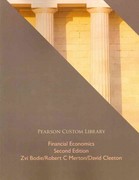Question
Finance 1. A bond has a $1,000 par value, 10 years to maturity, and an 8% annual coupon and sells for $980. a. What is
Finance
1. A bond has a $1,000 par value, 10 years to maturity, and an 8% annual coupon and sells for $980.
a. What is its yield to maturity (YTM)? Round your answer to two decimal places.
__%
b. Assume that the yield to maturity remains constant for the next four years. What will the price be 4 years from today?Do not round intermediate calculations. Round your answer to the nearest cent.
$____
2. Nesmith Corporation's outstanding bonds have a $1,000 par value, an 8% semiannual coupon, 6 years to maturity, and a 12% YTM. What is the bond's price? Round your answer to the nearest cent.
$____
3.
A firm's bonds have a maturity of 8 years with a $1,000 face value, have an 11% semiannual coupon, are callable in 4 years at $1,153.33, and currently sell at a price of $1,281.20. What are their nominal yield to maturity and their nominal yield to call? Do not round intermediate calculations. Round your answers to two decimal places.
YTM: _____%
YTC: ____%
What return should investors expect to earn on these bonds?
- Investors would expect the bonds to be called and to earn the YTC because the YTC is less than the YTM.
- Investors would expect the bonds to be called and to earn the YTC because the YTC is greater than the YTM.
- Investors would not expect the bonds to be called and to earn the YTM because the YTM is greater than the YTC.
- Investors would not expect the bonds to be called and to earn the YTM because the YTM is less than the YTC.
4. An investor has two bonds in his portfolio that have a face value of $1,000 and pay a 9% annual coupon. Bond L matures in 10 years, while Bond S matures in 1 year.
- What will the value of the Bond L be if the going interest rate is 5%, 7%, and 10%? Assume that only one more interest payment is to be made on Bond S at its maturity and that 10 more payments are to be made on Bond L. Round your answers to the nearest cent.
5% 7% 10% Bond L $ $ $ Bond S $ $ $ - Why does the longer-term bonds price vary more than the price of the shorter-term bond when interest rates change?
- Long-term bonds have lower reinvestment rate risk than do short-term bonds.
- The change in price due to a change in the required rate of return increases as a bond's maturity decreases.
- Long-term bonds have greater interest rate risk than do short-term bonds.
- The change in price due to a change in the required rate of return decreases as a bond's maturity increases.
- Long-term bonds have lower interest rate risk than do short-term bonds.
5. An investor has two bonds in her portfolio, Bond C and Bond Z. Each bond matures in 4 years, has a face value of $1,000, and has a yield to maturity of 9.1%. Bond C pays a 10.5% annual coupon, while Bond Z is a zero-coupon bond.
- Assuming that the yield to maturity of each bond remains at 9.1% over the next 4 years, calculate the price of the bonds at each of the following years to maturity. Round your answers to the nearest cent.
Years to Maturity Price of Bond C Price of Bond Z 4 $ Answer $ Answer 3 $ Answer $ Answer 2 $ Answer $ Answer 1 $ Answer $ Answer 0 $ Answer $ Answer - Select the correct graph based on the time path of prices for each bond.
6. Six years ago the Templeton Company issued 15-year bonds with a 14% annual coupon rate at their $1,000 par value. The bonds had a 9% call premium, with 5 years of call protection. Today Templeton called the bonds. Compute the realized rate of return for an investor who purchased the bonds when they were issued and held them until they were called. Round your answer to two decimal places.
_______%
Why should or should not the investor be happy that Templeton called them?
- Investors should not be happy. Since the bonds have been called, interest rates must have fallen sufficiently such that the YTC is less than the YTM. If investors wish to reinvest their interest receipts, they must do so at lower interest rates.
- Investors should be happy. Since the bonds have been called, interest rates must have risen sufficiently such that the YTC is greater than the YTM. If investors wish to reinvest their interest receipts, they can now do so at higher interest rates.
- Investors should be happy. Since the bonds have been called, investors will receive a call premium and can declare a capital gain on their tax returns.
- Investors should be happy. Since the bonds have been called, investors will no longer need to consider reinvestment rate risk.
THANK YOU (:
Step by Step Solution
There are 3 Steps involved in it
Step: 1

Get Instant Access to Expert-Tailored Solutions
See step-by-step solutions with expert insights and AI powered tools for academic success
Step: 2

Step: 3

Ace Your Homework with AI
Get the answers you need in no time with our AI-driven, step-by-step assistance
Get Started


